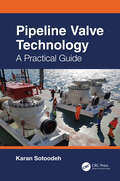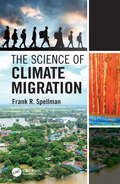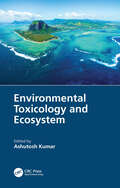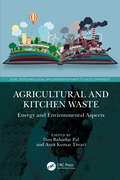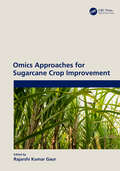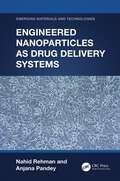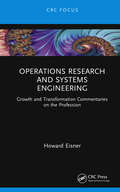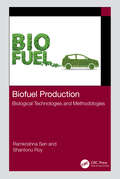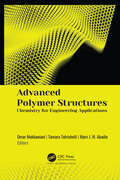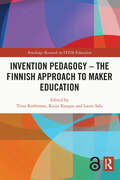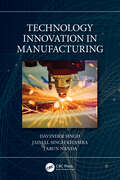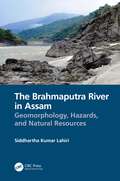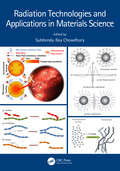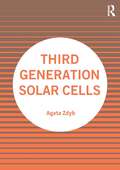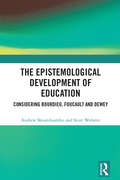- Table View
- List View
Pipeline Valve Technology: A Practical Guide
by Karan SotoodehThis book covers the life cycle of pipeline valves, the largest and most essential valves in offshore pipeline engineering. Discussing the design process, testing, production, transportation, installation, and maintenance, the book also covers the risk analysis required to assess the reliability of these valves. Pipeline valves require particular attention to ensure they are safely designed, installed, and maintained, due to the high stakes. Failure would result in environmental pollution, the destruction of expensive assets, and potential loss of life. Proper installation and upkeep require specialist processes throughout the life cycle of the valve. This book is a key guide to these processes. Beginning by looking at the design of pipeline valves, this book details how conserving weight and space is prioritized, how materials are chosen, how thickness is calculated, and how leakage is minimized. It then discusses production and specific welding techniques to bond dissimilar materials, alongside casting and machining. Building on other discussions in the text with case studies and questions and answers for self-study, this book is the ideal guide to pipeline valves. This book will be of interest to professionals in the industries of offshore oil and gas, material engineering, coatings, mechanical engineering, and piping. It will also be relevant to students studying coating and welding, or mechanical, piping, or petroleum engineering.
The Science of Climate Migration
by Frank R. SpellmanThis book addresses the nexus between science and migration and examines how the two are inextricably intertwined. The Science of Climate Migration primarily addresses the science of global climate change and additionally examines how this change is more than a region being too hot, too cold, too dry, too wet, or too windy; rather it is also about heightened military tensions, political instability, and myriad other factors. History has shown that this change is felt most acutely in developing countries that are least equipped to adapt. This inability to adapt is considered to be a driver that motivates local residents to find “greener pastures” through migration. Further, the book discusses the increasing need for the implementation and utilization of non-polluting renewables for use in energy production as a means to stave off environmental crises. Features Examines how and why climate change effects and human migration are inextricably intertwined. Discusses the increasing need for the implementation of non-polluting renewables for use in energy production as a means to stave off environmental crises. Explains how wildlife is also sensitive to shifts in climate and how this in turn affects their migration as well.
Environmental Toxicology and Ecosystem
by Ashutosh KumarThis book covers varied aspects of environmental contaminants and their effect on the living organisms. It addresses the basics of ecotoxicity assessment, interaction of the abiotic or biotic factors with the novel chemical entities, and the fate of the natural organic matter upon interaction with new chemical entities. It further includes models for ecotoxicity studies and high-throughput approaches including OMICS. It provides an overview of the ecological risk assessment, regulatory toxicology guidelines, and possible roadmaps for protection of environmental health. Features: Discusses environmental toxicology facets and their effects on the ecosystem. Provides an introduction of environmental toxicology keeping in view the paradigm shift on entry of novel materials in the environment. Includes bioavailability, bioconcentration, and biomagnification of trophic transfer of pollutants. Covers high-throughput approaches for ecotoxicity assessment. Explores roadmaps for environmental protection and sustainable development. This book is geared toward graduate students and researchers in Environmental Sciences and Engineering, Toxicology, and Ecology.
The Science of Climate Migration
by Frank R. SpellmanThis book addresses the nexus between science and migration and examines how the two are inextricably intertwined. The Science of Climate Migration primarily addresses the science of global climate change and additionally examines how this change is more than a region being too hot, too cold, too dry, too wet, or too windy; rather it is also about heightened military tensions, political instability, and myriad other factors. History has shown that this change is felt most acutely in developing countries that are least equipped to adapt. This inability to adapt is considered to be a driver that motivates local residents to find “greener pastures” through migration. Further, the book discusses the increasing need for the implementation and utilization of non-polluting renewables for use in energy production as a means to stave off environmental crises. Features Examines how and why climate change effects and human migration are inextricably intertwined. Discusses the increasing need for the implementation of non-polluting renewables for use in energy production as a means to stave off environmental crises. Explains how wildlife is also sensitive to shifts in climate and how this in turn affects their migration as well.
Environmental Toxicology and Ecosystem
by Ashutosh KumarThis book covers varied aspects of environmental contaminants and their effect on the living organisms. It addresses the basics of ecotoxicity assessment, interaction of the abiotic or biotic factors with the novel chemical entities, and the fate of the natural organic matter upon interaction with new chemical entities. It further includes models for ecotoxicity studies and high-throughput approaches including OMICS. It provides an overview of the ecological risk assessment, regulatory toxicology guidelines, and possible roadmaps for protection of environmental health. Features: Discusses environmental toxicology facets and their effects on the ecosystem. Provides an introduction of environmental toxicology keeping in view the paradigm shift on entry of novel materials in the environment. Includes bioavailability, bioconcentration, and biomagnification of trophic transfer of pollutants. Covers high-throughput approaches for ecotoxicity assessment. Explores roadmaps for environmental protection and sustainable development. This book is geared toward graduate students and researchers in Environmental Sciences and Engineering, Toxicology, and Ecology.
Agricultural and Kitchen Waste: Energy and Environmental Aspects (Novel Biotechnological Applications for Waste to Value Conversion)
by Dan Bahadur Pal Amit Kumar TiwariApart from being termed as a pollution source, agriculture and kitchen waste is also a rich source of carbohydrates, minerals, antioxidants and vitamins, and can be utilized to develop value-added products and for energy production, which is the main theme of this book. It also focuses on the minimization of this waste via different routes like conversion into bio-fertilizers, organic acids, other industrial products, and efficient energy production. It comprises different topics and concepts related to waste utilization contributed by recognized researchers and experts. Features: Covers all the technical aspects of utilization of agricultural and kitchen waste. Discusses the quality characteristics of value-added products. Provides overview of different options for processing of organic wastes. Includes production of acids and enzymes from agriculture/kitchen wastes. Reviews effects of kitchen/agricultural waste on environment and its role in pollution control. This book is aimed at researchers and graduate students in chemical and environmental engineering.
Agricultural and Kitchen Waste: Energy and Environmental Aspects (Novel Biotechnological Applications for Waste to Value Conversion)
by Dan Bahadur Pal Amit Kumar TiwariApart from being termed as a pollution source, agriculture and kitchen waste is also a rich source of carbohydrates, minerals, antioxidants and vitamins, and can be utilized to develop value-added products and for energy production, which is the main theme of this book. It also focuses on the minimization of this waste via different routes like conversion into bio-fertilizers, organic acids, other industrial products, and efficient energy production. It comprises different topics and concepts related to waste utilization contributed by recognized researchers and experts. Features: Covers all the technical aspects of utilization of agricultural and kitchen waste. Discusses the quality characteristics of value-added products. Provides overview of different options for processing of organic wastes. Includes production of acids and enzymes from agriculture/kitchen wastes. Reviews effects of kitchen/agricultural waste on environment and its role in pollution control. This book is aimed at researchers and graduate students in chemical and environmental engineering.
Omics Approaches for Sugarcane Crop Improvement
by Rajarshi Kumar GaurIn this book, the information encompasses various researchable biotechnology aspects of sugarcane, its genomic structure, diversity, comparative and structural genomics, data mining, etc. This book explores both the theoretical and practical aspects of sugarcane crops, focusing on innovative processes. This book argues in favor of developing an integrated research and development system to strengthen the research and development capabilities of all the areas of sugarcane. Further, it covers the recent trends of sugarcane biotechnology, especially in the next-generation sequencing (NGS) era. This book will be very useful for professors and scientists who are working in the area of sugarcane crops by using molecular biology and bioinformatics. It is also useful for students to use as a reference for their classes or thesis projects. Key features: • Discusses an integral part of molecular biology and pivotal tools for molecular breeding; enables breeders to design cost-effective and efficient breeding strategies for sugarcane • Discusses the harnessing genomics technologies for genetic engineering and pathogen characterization and diagnosis of sugarcane • Provides new examples and problems, added where needed • Provides insight from contributors drawn from around the globe
Omics Approaches for Sugarcane Crop Improvement
by Rajarshi Kumar GaurIn this book, the information encompasses various researchable biotechnology aspects of sugarcane, its genomic structure, diversity, comparative and structural genomics, data mining, etc. This book explores both the theoretical and practical aspects of sugarcane crops, focusing on innovative processes. This book argues in favor of developing an integrated research and development system to strengthen the research and development capabilities of all the areas of sugarcane. Further, it covers the recent trends of sugarcane biotechnology, especially in the next-generation sequencing (NGS) era. This book will be very useful for professors and scientists who are working in the area of sugarcane crops by using molecular biology and bioinformatics. It is also useful for students to use as a reference for their classes or thesis projects. Key features: • Discusses an integral part of molecular biology and pivotal tools for molecular breeding; enables breeders to design cost-effective and efficient breeding strategies for sugarcane • Discusses the harnessing genomics technologies for genetic engineering and pathogen characterization and diagnosis of sugarcane • Provides new examples and problems, added where needed • Provides insight from contributors drawn from around the globe
Engineered Nanoparticles as Drug Delivery Systems (Emerging Materials and Technologies)
by Nahid Rehman Anjana PandeyThis book highlights application of nanomaterials for drug delivery, therapy, and engineering. It covers stimuli-sensitive drug delivery systems including an overview of the physical, chemical, biological, and multi-stimuli-responsive nanosystems. It also presents analysis of clinical status for different types of nanoplatforms and assesses novel applications of nanomaterials in the areas of smart delivery and drug targeting. It further discusses the advantages and disadvantages of each application of pertinent nanomaterials. Features: Provides academic introduction to the uses of nanotechnology in drug delivery. Discusses use of nanomaterials in targeting a drug to specific tissues and cells. Presents an analysis of clinical status for different types of nanoplatforms. Covers applications in drug delivery, therapy, and engineering. Focuses on how novel nanotechnology-orientated methods can help improve treatment. This book is aimed at researchers and graduate students in biomedical and biochemical engineering, pharmaceutical, chemical and bioprocess engineering, materials science, and drug delivery mechanisms.
Engineered Nanoparticles as Drug Delivery Systems (Emerging Materials and Technologies)
by Nahid Rehman Anjana PandeyThis book highlights application of nanomaterials for drug delivery, therapy, and engineering. It covers stimuli-sensitive drug delivery systems including an overview of the physical, chemical, biological, and multi-stimuli-responsive nanosystems. It also presents analysis of clinical status for different types of nanoplatforms and assesses novel applications of nanomaterials in the areas of smart delivery and drug targeting. It further discusses the advantages and disadvantages of each application of pertinent nanomaterials. Features: Provides academic introduction to the uses of nanotechnology in drug delivery. Discusses use of nanomaterials in targeting a drug to specific tissues and cells. Presents an analysis of clinical status for different types of nanoplatforms. Covers applications in drug delivery, therapy, and engineering. Focuses on how novel nanotechnology-orientated methods can help improve treatment. This book is aimed at researchers and graduate students in biomedical and biochemical engineering, pharmaceutical, chemical and bioprocess engineering, materials science, and drug delivery mechanisms.
Operations Research and Systems Engineering: Growth and Transformation Commentaries on the Profession
by Howard EisnerThis book presents an overview of operations research and systems engineering and takes a look into both fields on content, histories, contributions, and future directions so a sound career choice can be made for those who might be deciding on a career path. The book also offers how these two fields can be integrated and used in current times and into the future. Operations Research and Systems Engineering: Growth and Transformation traces the history of both fields of research as well as offers comments on the importance of both areas of study. By taking a look back with a historical perspective and also looking forward with the presentation of applications currently being used, someone looking to make a sound career choice will be able to decide which area they want to move towards. The book also offers how to integrate both operations research methods with systems engineering concepts and tools and provides a comparison between the two, along with how they can work together in the future. The goal of this book is to provide the reader with enough information so they can move forward with their career goals. It is also an ideal book that provides engineers, scientists, and mathematicians with a way to broaden their knowledge and areas of study.
Operations Research and Systems Engineering: Growth and Transformation Commentaries on the Profession
by Howard EisnerThis book presents an overview of operations research and systems engineering and takes a look into both fields on content, histories, contributions, and future directions so a sound career choice can be made for those who might be deciding on a career path. The book also offers how these two fields can be integrated and used in current times and into the future. Operations Research and Systems Engineering: Growth and Transformation traces the history of both fields of research as well as offers comments on the importance of both areas of study. By taking a look back with a historical perspective and also looking forward with the presentation of applications currently being used, someone looking to make a sound career choice will be able to decide which area they want to move towards. The book also offers how to integrate both operations research methods with systems engineering concepts and tools and provides a comparison between the two, along with how they can work together in the future. The goal of this book is to provide the reader with enough information so they can move forward with their career goals. It is also an ideal book that provides engineers, scientists, and mathematicians with a way to broaden their knowledge and areas of study.
Biofuel Production: Biological Technologies and Methodologies
by Ramkrishna Sen Shantonu RoyBiofuels and bioenergy have emerged as an alternative option based on their sustainability, concomitant waste treatment, and site-specific flexibility. This book encompasses all the knowhow of different biofuel production processes through biological methods. It describes recent advancements in all major biofuel technologies such as biohydrogen, biomethane, bioethanol, syngas and so forth. Related protocols supported by schematic representation are included, encompassing comprehensive up-to-date scientific and technological information in biofuels and bioenergy. Features: Includes practical approaches focused on process design and analysis in biofuel production via biological routes Discusses kinetic equations of different microbial systems Provides comprehensive coverage of biochemical kinetics and equations related to biofuel process Describes protocols for setting up of experiments for pertinent biofuel technologies Emphasis on practical engineering approaches and experiments This book is aimed at researchers and graduate students in chemical, biochemical and bioprocess engineering, and biofuels.
Biofuel Production: Biological Technologies and Methodologies
by Ramkrishna Sen Shantonu RoyBiofuels and bioenergy have emerged as an alternative option based on their sustainability, concomitant waste treatment, and site-specific flexibility. This book encompasses all the knowhow of different biofuel production processes through biological methods. It describes recent advancements in all major biofuel technologies such as biohydrogen, biomethane, bioethanol, syngas and so forth. Related protocols supported by schematic representation are included, encompassing comprehensive up-to-date scientific and technological information in biofuels and bioenergy. Features: Includes practical approaches focused on process design and analysis in biofuel production via biological routes Discusses kinetic equations of different microbial systems Provides comprehensive coverage of biochemical kinetics and equations related to biofuel process Describes protocols for setting up of experiments for pertinent biofuel technologies Emphasis on practical engineering approaches and experiments This book is aimed at researchers and graduate students in chemical, biochemical and bioprocess engineering, and biofuels.
Advanced Polymer Structures: Chemistry for Engineering Applications
by Omar Mukbaniani Tamara Tatrishvili Marc Jean M. AbadieTaking an interdisciplinary approach, this new book considers state-of-the-art developments and research in polymer science, such as advanced polymers, composites and nanocomposites, and the role of polymers in the progress of green chemistry and medicine. Polymers are studied in fields as diverse as polymer science (polymer chemistry and polymer physics), biophysics, biochemistry, and more generally in materials science and engineering. Polymer matrix composites (PMCs) and nanocomposites (PMNCs) are widely used in hightech material structures such as in the automotive, marine, and aerospace industries. Their impact on the physical and mechanical performance is mainly due to their reinforcing agents, fibers (glass, carbon, aramid) or nanofibers (MMT, CNTs, graphene, etc) but also due to a perfect mastery of the matrix/reinforcement interface.
Invention Pedagogy – The Finnish Approach to Maker Education (Routledge Research in STEM Education)
by Tiina Korhonen Kaiju Kangas Laura SaloThis collection, edited and written by the leading scholars and experts of innovation and maker education in Finland, introduces invention pedagogy, a research-based Finnish approach for teaching and learning through multidisciplinary, creative design and making processes in formal school settings. The book outlines the background of, and need for, invention pedagogy, providing various perspectives for designing and orchestrating the invention process while discusses what can be learnt and how learning happens through inventing. In addition, the book introduces the transformative, school-level innovator agency needed for developing whole schools as innovative communities. Featuring informative case study examples, the volume explores the theoretical, pedagogical, and methodological implications for the research and practice of invention pedagogy in order to further the field and bring new perspectives, providing a new vision for schools for decades to come. Intermixing the results of cutting-edge research and best practice within STEAM-education and invention pedagogy, this book will be essential reading for researchers, students, and scholars of design and technology education, STEM education, teacher education, and learning sciences more broadly.
Invention Pedagogy – The Finnish Approach to Maker Education (Routledge Research in STEM Education)
by Tiina Korhonen Kaiju Kangas Laura SaloThis collection, edited and written by the leading scholars and experts of innovation and maker education in Finland, introduces invention pedagogy, a research-based Finnish approach for teaching and learning through multidisciplinary, creative design and making processes in formal school settings. The book outlines the background of, and need for, invention pedagogy, providing various perspectives for designing and orchestrating the invention process while discusses what can be learnt and how learning happens through inventing. In addition, the book introduces the transformative, school-level innovator agency needed for developing whole schools as innovative communities. Featuring informative case study examples, the volume explores the theoretical, pedagogical, and methodological implications for the research and practice of invention pedagogy in order to further the field and bring new perspectives, providing a new vision for schools for decades to come. Intermixing the results of cutting-edge research and best practice within STEAM-education and invention pedagogy, this book will be essential reading for researchers, students, and scholars of design and technology education, STEM education, teacher education, and learning sciences more broadly.
Technology Innovation in Manufacturing
by Davinder Singh Jaimal Singh Khamba Tarun NandaThis text identifies and discusses different technology innovation initiatives (TIIs) such as entrepreneurial capability, technology infrastructure capability, organizational culture and climate, and government initiatives. It further evaluates the relationship between various technology innovation initiatives and manufacturing performances using multi-criteria decision-making techniques such as fuzzy set theory (FST), structural equation modeling (SEM), and analytic hierarchy process (AHP). It will serve as an ideal reference text for graduate students and academic researchers in the field of industrial engineering, manufacturing engineering, mechanical engineering, automotive engineering. This book: • Discusses technology innovation initiatives such as entrepreneurial capability, technology infrastructure capability, and organizational culture. • Highlights technology innovation-strategy model in assisting manufacturing industries for enhancing their performance in today’s competitive environment. • Examines the effect of technology innovation initiatives on the performance of manufacturing industries. • Covers multi-criteria decision-making techniques such as fuzzy set theory, structural equation modeling, and analytic hierarchy process. • Explores the validation of fuzzy-based technology innovation model through structural equation modeling.
Technology Innovation in Manufacturing
by Davinder Singh Jaimal Singh Khamba Tarun NandaThis text identifies and discusses different technology innovation initiatives (TIIs) such as entrepreneurial capability, technology infrastructure capability, organizational culture and climate, and government initiatives. It further evaluates the relationship between various technology innovation initiatives and manufacturing performances using multi-criteria decision-making techniques such as fuzzy set theory (FST), structural equation modeling (SEM), and analytic hierarchy process (AHP). It will serve as an ideal reference text for graduate students and academic researchers in the field of industrial engineering, manufacturing engineering, mechanical engineering, automotive engineering. This book: • Discusses technology innovation initiatives such as entrepreneurial capability, technology infrastructure capability, and organizational culture. • Highlights technology innovation-strategy model in assisting manufacturing industries for enhancing their performance in today’s competitive environment. • Examines the effect of technology innovation initiatives on the performance of manufacturing industries. • Covers multi-criteria decision-making techniques such as fuzzy set theory, structural equation modeling, and analytic hierarchy process. • Explores the validation of fuzzy-based technology innovation model through structural equation modeling.
The Brahmaputra River in Assam: Geomorphology, Hazards, and Natural Resources
by Siddhartha Kumar LahiriThis holistic book covers the richest area in North East India in terms of both explored and foreseen reserves of fossil fuels and other natural resources. Using a multidisciplinary approach, GIS, and geospatial data gathered from different case studies included, this book helps readers develop a thorough understanding of a highly dynamic big river, the Brahmaputra, and use it as a comprehensive resource for further understanding the science of rivers. It discusses the causal factors of decadal-scale fluvial dynamics, the nature of fluvial dynamics, lateral variability of the older flood plains and neotectonics in the shallow subsurface, and the overall trend of basin evolution at different depths.
Radiation Technologies and Applications in Materials Science
by Subhendu Ray ChowdhuryThis book explains various kinds of non-ionizing and high-energy radiations, their interaction with materials and chemical reactions, and conditions of various kinds of materials development technologies including applications. It covers a processing-structure-property relationship and radiations used in developing many advanced materials used in various fields. It highlights application-oriented materials synthesis and modification covering a wide variety of materials such as plastics, rubber, thermo-set, ceramics, and so forth by various radiations. Features: Explains ionizing and non-ionizing radiation-assisted materials development technologies, for polymers, ceramics, metals, and carbons. Covers radiation-assisted synthesis, processing, and modification of all kinds of materials. Provides comparative studies, merits, demerits, and applications very systematically. Criss-crosses polymers science and technology, radiation technology, advanced materials technology, biomaterials technology, and so forth. Includes a section on 3D printing by LASER melting of CoCr alloys. This book is aimed at researchers and graduate students in materials science, radiation chemistry and physics, and polymer and other materials processing.
The Brahmaputra River in Assam: Geomorphology, Hazards, and Natural Resources
by Siddhartha Kumar LahiriThis holistic book covers the richest area in North East India in terms of both explored and foreseen reserves of fossil fuels and other natural resources. Using a multidisciplinary approach, GIS, and geospatial data gathered from different case studies included, this book helps readers develop a thorough understanding of a highly dynamic big river, the Brahmaputra, and use it as a comprehensive resource for further understanding the science of rivers. It discusses the causal factors of decadal-scale fluvial dynamics, the nature of fluvial dynamics, lateral variability of the older flood plains and neotectonics in the shallow subsurface, and the overall trend of basin evolution at different depths.
Third Generation Solar Cells
by Agata ZdybThis book presents the principle of operation, materials used and possible applications of third generation solar cells that are under investigation and have been not commercialized on a large scale yet. The third generation photovoltaic devices include promising emerging technologies such as: organic, dye sensitized, perovskite and quantum dot sensitized photocells. This book introduces the reader to the basics of third generation photovoltaics and presents in an accessible way phenomena and a diversity of materials used. In this book one will find the description of the working principle of new promising solar technologies, their advantages and disadvantages, prospect applications and preliminary analysis of their impact on the environment. The fundamentals of traditional solar cell operation are also included in the book facilitating understanding of new ideas. This book is ideal reading for everyone who is interested in novel solutions in photovoltaics as well as applications of nanotechnology, photochemistry and materials research.
The Epistemological Development of Education: Considering Bourdieu, Foucault and Dewey
by Andrew Skourdoumbis Scott WebsterThis book documents the political and economic ramifications of the policy impetus for a ‘science of education’ and what this means for classroom teachers, their teaching practices and for the field of education. In a critical exploration of current research and policy articulations of the purposes of education, with attention given to Australia, the UK and the USA, this book delineates the evaluative mechanisms involved in the strategic science as method adoption of accountability, competitiveness and test-driven criteria used in major education policy. It brings together the disciplines of sociology and philosophy by drawing on the theoretical insights of Michel Foucault, Pierre Bourdieu and John Dewey. In addition, the book argues for the deliberate use of the theoretical in education and is against the contemporary unquestioning advocacy that often accompanies a narrowly defined master narrative of a science of education. This book will be of special interest to post-graduate students as source material in general education courses and is also intended for academics with an interest in educational theory/philosophy and the sociology of education.
